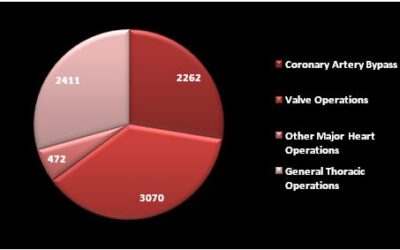Key Features of Barlow’s Disease:
60-year-old patient with a heart murmur for many years was diagnosed with mitral valve prolapse six years ago. She was on medication for the heart murmur and was diagnosed with an echocardiogram, at which time they discovered the mitral valve prolapse in both leaflets. The cardiologist suggested surgery, but the patient wanted a second opinion due to her hesitance. It was recommended that she have an echo every six months.
Then, the patient began to feel unwell with shortness of breath. Her doctor moved the surgery window from six months to four months to check on it. The patient decided to have the surgery. It was noted that her heart was already getting a little bit enlarged, which caused concern, as that is one of the
indications of severity. She was diagnosed with Barlow’s syndrome, or Barlow’s disease, which is excessive tissue of both leaflets, know as bi-leaflet prolapse. We had to repair the anterior leaflet and the posterior leaflet, and put a ring in, and we did a follow-up echo, not only in the operating room, but also right before discharge yesterday. The echo was perfect. She has no further mitral leakage nor stenosis. She does have SAM, systolic anterior motion, because she has an asymmetric septal hypertrophy (a little extra muscle knuckle).
She was discharged four days after surgery and says the pain after her conventional sternotomy is minimal.


Recent Posts
Patient Q&A: 4 Days After Jim’s Mitral Valve Repair
Thank you, Adam Pick, for highlighting this story on HeartValveSurgery.com! Your dedication to educating patients about the latest developments in heart valve surgery has made a significant impact. I am personally grateful for the knowledge, support, and community...
When is the Best Time to Exercise?
This video talks about the advantages of exercising in the morning. Morning workouts release endorphins and improve blood flow, helping you to feel more energized and mentally sharp throughout your day. There are fewer distractions in the morning and it makes it...
May is Mental Health Awareness Month
Let’s take this opportunity to reflect on something essential, yet often overlooked in professional environments: our mental well-being. In a world that values productivity and performance, it’s easy to forget that behind every deadline, meeting, or project is a human...
10 Jefferson Hospitals Earn an “A” Safety Grade
We are incredibly proud to announce that 10 Jefferson Health hospitals have received an "A" Hospital Safety Grade from The Leapfrog Group for Spring 2025. This recognition underscores our commitment to improve patient lives and prioritize their safety across our...
Patient Outcomes – May 1, 2025
Nothing can be more important than knowing the experience level of your surgeon. Generally speaking, the more you do something, the better you become! Since entering practice in 1992, I have performed over 8,215 major heart and lung operations and numerous minor...
Day #5 After CABG Surgery
With the patient’s permission, this video discusses the post-operative journey of an individual who underwent urgent/emergent conventional sternotomy, triple-vessel coronary artery bypass graft (CABG) surgery, after developing severe chest pain with ECG changes during...
Featured
Pages
- Learn about heart valves. Heart Valves
- Read testimonials. Testimonials
- Did you know I have a consulting firm? Singer Heart/Lung Consulting
- Check out my TedTalk! Defining Success
Links
- Links page with more information about your heart. Links
- Dr. Adam Pick's Site: heart-valve-surgery.com
Questions? Comments?
Reach out to me here:













